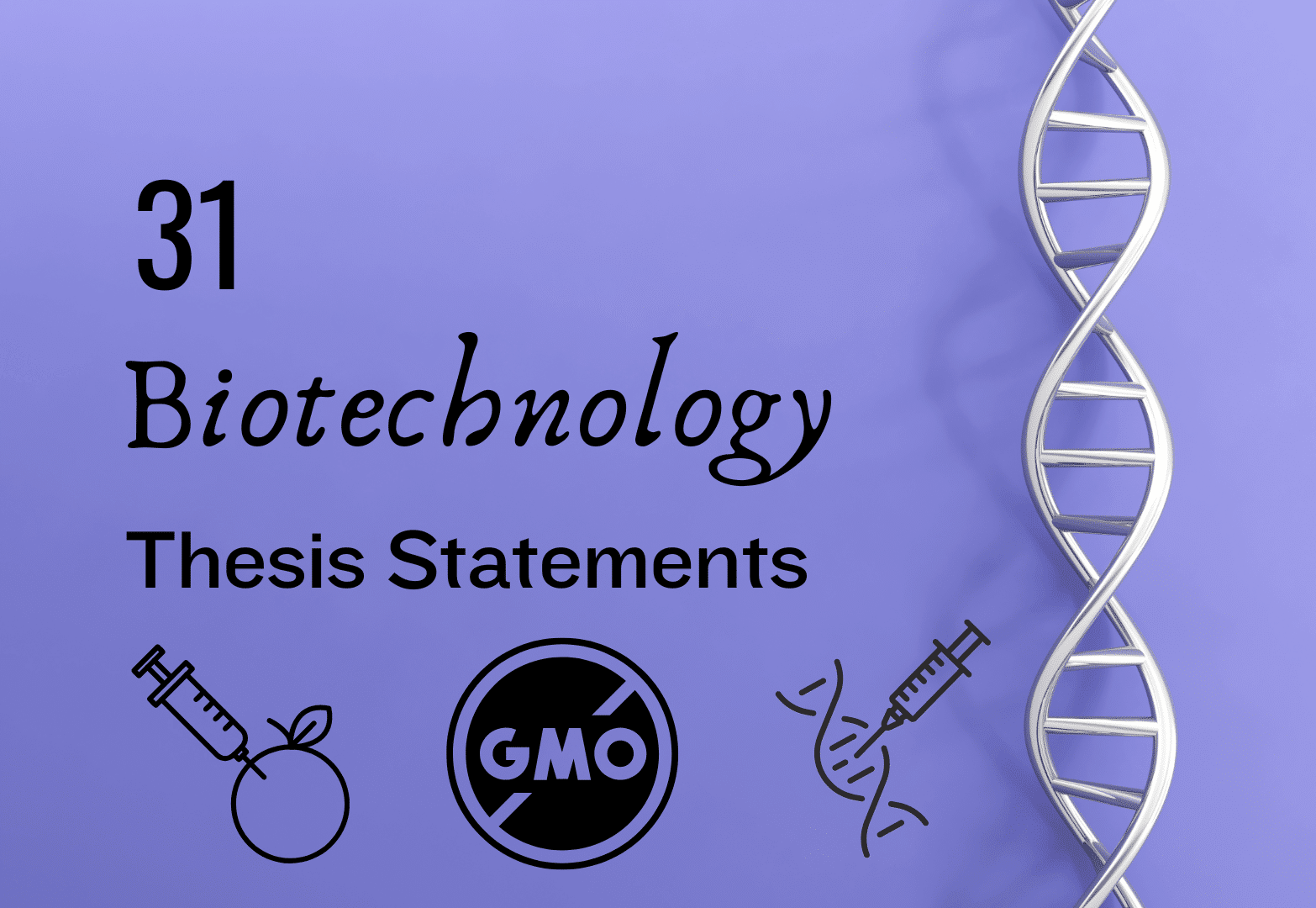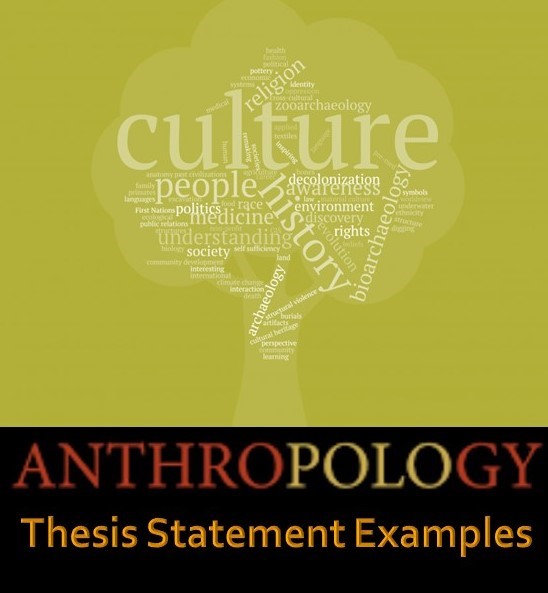A thesis statement portrays the central idea of your research paper or essay. Not everyone is an expert at writing a coherent, well-structured thesis statement, so they need assistance from reliable websites to find a strong thesis statement for their essay. Before writing a statement for a subject like biotechnology, you must do a little homework beforehand. To ease the process, we have written down 31 biotechnology thesis statement that can help you compile a perfect research paper.

- Problems in Clinical Trials for Emerging Respiratory Viruses
Respiratory viruses are the leading cause of mortality in children. As viruses can mutate easily, it becomes difficult to carry out clinical trials. Dealing with emerging viruses has always remained a high-alert task.
- Future Aspects of CRISPR-Cas in the Agriculture Sector
CRISPR-Cas-based editing of rice genomes opens up opportunities in the development of commercial crop plants. Various steps under controlled conditions are carried out for the genome editing process, which includes planning, vector construction, the transformation of plants, screening at the molecular level, plant phenotyping, and field trials.
- Novel Strategies to Protect Grapevine from Viruses Invasion
Protection of grapevine from viruses is unavoidable. Therefore, such strategies need to be adopted that provide a habitat for the least dangerous viral strains to co-exist with the plants without causing notable harm to the crops.
- Significance of Breast Cancer Screening
Breast cancer screening at regular intervals is crucial to receiving an early diagnosis of the disease. Once the tumour enters the bloodstream, it can spread rapidly and damage other organs quickly. A delayed diagnosis might lead to distant metastases and a poor prognosis.
- Consequences of Skin-Related Antibiotic Abuse
Excessive use of antibiotics to treat skin-related issues can do more harm than good. It is critical to emphasise the risks of antibiotic overprescription, as it kills good bacteria and results in the expansion of antibiotic-resistant strains, thus disturbing the body’s largest organ microbiome.
- Upscaling of Jatropha curcas L. Biomass Availability
Jatropha curcas L. is used as the feedstock in the production of biodiesel. Techniques such as in-vitro plant propagation, somatic embryogenesis, gene transformation studies, production of haploids, and development of elite germplasm are required to upscale its biomass availability globally.
- Application of Plant Biotechnology to Prevent HIV
Several antibody therapies are already known to prevent HIV infection, but the production of other therapeutic antibodies and proteins using plant biotechnology reduces the overall cost of the system. Compared to bioreactor-based processes, this system requires less money to produce strong anti-HIV antibodies.
- Use of White Rot Fungi to Control Environmental Pollution
One of the important tools of biotechnology used to control environmental pollution is white rot fungi (WRFs). Using mycoremediation, WRF degrades the lignin using its mycelia. The mycelium punctures the cell cavity and allows the ligninolytic enzymes (LEM) to release, which then forms the sponge-like mass in white color.
- Application of KCM-R5 to Detoxify Industrial Waste Water
High quantities of phenol in the industrial waste can be hazardous to living organisms. The P. rhodesiae KCM-R5 bacterium can make biofilm and is capable of degrading phenol and its derivatives by using phenol in its metabolism. Therefore, engineered PEO cryogel-P. rhodesiae KCM R5 biofilms can be used to treat industrial wastewater detoxification.
- Cinnamomum cassia Uses as an Anti-cancer and Anti-oxidant Herb
Cinnamomum cassia is a valuable medicinal herb with anti-cancer and antioxidant properties. Fermenting the cinnamon with Lactobacillus Plantarum enhances the phenolic compounds and flavonoids, subsequently improving the plants’ anti-cancer and antioxidant capabilities.
- Treatment of Wastewater by the Use of L. monocytogenes
The human pathogen L. monocytogenes is a potential organism to carry out bioremediation. It is a solvent-tolerant organism that secretes solvent-stable lipase that can readily break down polyester plastic and lipids in wastewater streams.
- Improvement of Plant Growth under Salinity Stress
Salinity stress is one of the main abiotic factors that restrict crop growth. Plant growth in saline environments can be improved by using Bacillus safensis PM22 as a bio-inoculant or biofertilizer. This PGPR can increase photosynthetic efficiency, antioxidant levels, osmoprotectant synthesis, and decreased oxidative stress markers.
- Role of L.reutri Probiotics in the Treatment of Peptic Ulcer
Peptic ulcer disease is commonly caused by H. pylori infection and aspirin use. Using antibiotics with L. reuteri probiotics is beneficial which causes the good bacteria to serve as ulcer biotherapy, promoting mucus secretion, reducing the size of ulcer and the number of pathogens in the body.
- Importance of Pyrabactin Resistance 1 in Sense-Response Function
To improve the sense-response function, a quick transformation of biosensors using an abscisic acid receptor obtained from a plant PYR1 (Pyrabactin Resistance 1), which binds to a malleable binding pocket, is needed. It is required to heterodimerize a ligand.
- Significance of mRNA Expression
The amount of total mRNA expressed in a cell is essential to determine the clinical outcomes of the cells using tumor phenotypes. Intra-tumor genetic heterogeneity, altered genes, and trends in metabolic dysfunction impact the total mRNA expression (TmS) by cancer-specific marking.
- Role of HiFi-DdCBEs in Therapeutic Treatments
Unlike conventional DdCBEs that result in undesirable off-target conversions of C-to-T in mitochondrial DNA (mtDNA) of humans, the whole sequencing of the mitochondrial genome shows HiFi-DdCBEs are extremely precise and structured. This system keeps off-target mutations away, thus resulting in the efficient application of therapeutic treatments.
- Application of Selective Time-Resolved Anisotropy in Molecular Biotechnology
With the help of a detection technique called fluorescence anisotropy in molecular biotechnology, the development of macromolecules can be studied using the changes in their rotational potency. STARSS (selective time-resolved anisotropy with reversibly switchable states) is used to improve the limitations of this system as it can probe large structures, which helps in studying the whole proteome of a human.
- Replacement of Conventional Organoid Culture to Expand Organoid
Conventional organoid culture can be replaced with the engineered approach that transforms single injections of stem cells into arrays of structures similar to organs in a dish. This system is scalable and enables the growth and expansion of organoids, so it can be continued without passaging.
- Significance of Transgenic Plant Production
An application of transgenic plant biotechnology results in the production of consumable oral vaccines. The purpose can be achieved by using a glycoprotein gene (G-protein) that covers the surface of the rabies virus to be expressed in tomato plants. Transformation of cotyledons is mediated by Agrobacterium tumefaciens in plants.
- Study of Transcription by Synthetic Gene Circuits
To produce precise and programmable outcomes, synthetic gene circuits with multiple input signals that can be customized has been used. The system can be employed to study unrealized traits of plants and precisely constructed programs related to the process of transcription in cells.
- Use of Tannase in Animal Feed
To yield the substrate of an inducible enzyme, i.e., tannase, Citrus limetta peels can be used. This is a useful study as milk production and growth rates of animals are enhanced with the help of tannase, which degrades the tannin, thus producing gallic acid and glucose. The research further points toward low tannin-based animal feed at the industrial level.
- The Role of Lactobacillus in the Treatment of Kidney Diseases
Kidney diseases lead to obesity. The study shows the use of two different strains of Lactobacillus to improve kidney insufficiency and metabolic disorder, which is associated with obesity. A combination of Lactobacillus strains (Pro1 + Pro2) as a supplement of various juices and milk is essential for lowering obesity-associated kidney diseases.
- Bt-Resistance Role in Large-Scale Cultivation
To protect the cotton from the most destructive pest, i.e., the Pink Bollworm (Pectinophora gossypiella), a host plant resistance technique is needed. Large-scale cultivation can be protected using eco-friendly Bt-resistance. The growth of non-Bt crops helps control the Pink Bollworm.
- Production of Triticum aestivum L by RAPD Technique
Wheat (Triticum aestivum L.). is a staple food crop worldwide and can be studied using morphological markers. These markers focus on the detection of specific genes, which are of high interest economically. RAPD and similar molecular techniques can be employed.
- Application of Ganodermalucidium in Therapeutics
The RED LINGZHI MUSHROOM (Ganodermalucidum) is an important therapeutic agent that can be used to produce triterpenoids. The effect of potential ultrasonic radiations along with the solvent can be used to study the shortened extraction time and to produce a high yield of triterpenoids from various fruit bodies of G.lucidum.
- Microbiology Research to Recover Fossil Fuels
Dependence on fossil fuels is rising daily to meet energy and chemical feedstock needs. Microbiology plays a significant role in the oil industry via different microbial-induced processes. We can conduct research in the field of microbiology to recover fossil fuel energy resources. However, we will acquire renewable energy sources in the long run as our future economy depends on them.
- Overview of Transcriptomics and RNA Sequencing
DNA acts as a blueprint to transcribe genes and proteins to form organs as the cells undergo a differentiation process. Most of these transcriptional changes are physiological, but pathological changes also drive them in abnormal cases. Using transcriptomics and Next-Generation Sequencing, we can study these cellular phenotypes. In the future, we expect to study these techniques in clinical practice.
- Use of Microbes in Industrial Biotechnology
Industrial biotechnology is blooming as the chemical industry needs chemicals to produce fuels and solvents. Designing and establishing efficient factories to synthesize them is a big challenge. Metabolic engineering is used in the fermentation procedure, and it acquires transcriptome, proteome and metabolome analysis along with mathematical modeling. Moreover, systems biology can improve the cell factory development process.
- Synthesis and Use of Erythritol
Erythritol is a popular natural sweetener in the food industry. As the number of diabetes patients grows, so does the demand for lower-calorie foods. It is usually used as a sweetener in calorie-deficient foods. Its synthesis procedure is more challenging as compared to other polyols. It is needed to improve its concentration, productivity, and yield.
- Application of Blastobotrys adeninivorans in Biotechnology
A haploid yeast called Blastobotrys adeninivorans is a member of the subphylum Saccharomycotina. It has unusual characteristics, including thermo- and osmo-tolerance. Its genome is completely sequenced, and now many gene manipulations are possible. Therefore, it is a good host for gene expression. In addition, it has multiple applications in industrial biotechnology.
- Benefits of Anti-Ageing Products
Ageing is the leading cause of death. The slow process of ageing helps to provide many medical benefits. Different genes and pathways play a vital role in regulating the ageing process. Clinical trials address many challenges, ranging from anti-ageing understanding to commercializing anti-ageing products.
After reading all these thesis statement examples, you are now clear about trending topics in the biotech research field. Select the statement you apprehend the most and start writing for a research paper!



